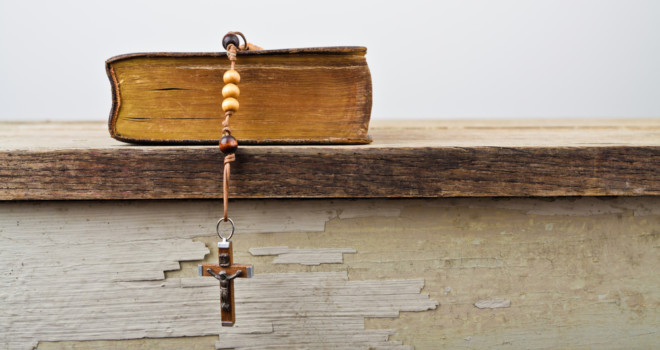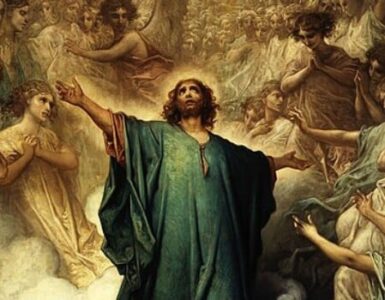We find the origins of the Liturgy of the Hours in the Old Testament. The psalms, the 150 prayers in the Old Testament, are the real basis of the Liturgy of the Hours. Throughout the Old Testament, we see the Jews praying the psalms. They prayed the psalms at regular hours.
Jesus Himself knew the psalms, quoted the psalms, and prayed the psalms.
Jesus not only prayed the psalms: He fulfilled them and revealed their deepest meaning. Jesus, Who is the fullness of God’s revelation, also reveals the fullness of the psalms. So, for example, the words “My God, my God, why have you abandoned me?” [Psalm 22:2] were the prayer of someone whose heart was in anguish and who cried out to God in a time of desperate need. These words as prayed by Jesus on the Cross, as they rise from His heart to the heavenly Father, now have a new richness for us. They reveal to us the heart of Jesus and His prayer in His time of suffering.
The same is true of all the psalms: All acquire a wonderful new richness in Jesus.
What did the Jews in the Old Testament, Jesus Himself, and the Christians of the New Testament find in the psalms? Why did they love these prayers and return to them so often?
The Many Prayers Within the Psalms

In the psalms, we encounter all kinds of prayers. We find prayers of confidence:
“The Lord is my shepherd; there is nothing I lack. . . . Even though I walk through the valley of the shadow of death, I will fear no evil, for you are with me; your rod and your staff comfort me” (Ps. 23:1, 4).
In times also of darkness, struggle, hopelessness, and anguish, the human heart finds here words for prayer: “Out of the depths I call to you, Lord; Lord, hear my cry!” (Ps. 130:1–2).
When the heart feels a deep longing for God, here in the psalms are the words it needs: “As the deer longs for streams of water, so my soul longs for you, O God” (Ps. 42:2); “O God, you are my God — it is you I seek!” (Ps. 63:2).
Other psalms permit the heart to voice great hope in God: “The Lord is my light and my salvation; whom should I fear?” (Ps. 27:1).
The psalms also give us words of praise when our hearts delight in the Lord and rejoice in the goodness of what He has done in our lives. The last five psalms are of this kind, as are many others. So, for example, Psalm 146: “Praise the Lord, my soul; I will praise the Lord all my life, sing praise to my God while I live” (Ps. 146:2).
Church Fathers and the Psalms
Saint
Ambrose describes the many ways in which the psalms bless us. A
psalm provides, he affirms, “a cry of happiness”: words to express joy in God.
A psalm:
- “soothes the temper”: a blessing so needed in a pressured age
- “distracts from care”: a repose our hearts
so often seek - “lightens the burden of sorrow”: a refuge so welcome in time of pain
And a psalm is: - “a source of security at night”: peace as the darkness of evening
falls - “a lesson of wisdom by day”: rich spiritual nourishment as the day
unfolds - “a shield when we are afraid”: a place of courage when we are
afraid - “a celebration of holiness”: a prayer that awakens longing for
sanctity - “a vision of serenity”: a calming of our
anxious hearts - “a promise of peace and harmony”: a place where our hearts can
rest
Who of us does not need these spiritual treasures? What will
happen in our lives if, through praying the psalms, this richness enters the
fabric of our daily prayer?
Saint Augustine describes what occurred when he was in church as the psalms were being sung:
“How I wept when I heard your hymns and canticles, being deeply moved by the sweet singing of your Church. Those voices flowed into my ears, truth filtered into my heart, and from my heart surged waves of devotion. Tears ran down, and I was happy in my tears.”
Who of us would not desire this blessing?
Early Christians & the Psalms
The remote origins of the Liturgy of the Hours lie in the Old Testament practice of praying the psalms, which was continued by Christians in the early Church. With the peace of Constantine in the fourth century, Christians could for the first time build churches and gather publicly to pray in them. There quickly arose a tradition of gathering in the church as the day began and again in the evening for what was called Morning and Evening Hymns — that is, the praying of the psalms.
Contemporary documents testify to this practice
throughout the early Church — in Palestine, Antioch, Constantinople, and
Africa. It is also attested in councils of bishops in Spain and elsewhere.
In the morning and in the evening, Christians gathered in the church. If a bishop was present, he would lead; otherwise a priest would lead. The people would sing the psalms provided for the morning or the evening. Because they did not vary, the people could learn them by heart and sing them tunefully.
Other prayers were added from other parts of the Bible. In some places, a brief homily was given. The service concluded with intercessions for the needs of the Church and a final prayer. The origins of the Liturgy of the Hours, which follows a similar format, are readily apparent in this practice.
At the same time, monastic life was developing, and the monks brought these devotions into their monasteries. Thus, two streams of prayer developed: the people’s office and the monastic office. As time passed and habits changed, the people’s office waned and the Liturgy of the Hours passed almost exclusively — though never entirely — into the monasteries and thus became largely identified with the prayer of monks.
Sunday Vespers
A vestige of the earlier people’s office endured,
however, in the practice of Sunday evening Vespers in parishes. This tradition
was never lost.
A pilgrim who went to the parish of the Curé d’Ars (St. John Vianney) in the mid-nineteenth century, when the renown of the saint was at its height, left a record of a typical Sunday in the parish. The people attended Mass in the morning in a packed church. At one o’clock, the bells would ring, and people returned to the church for a catechetical instruction and to pray Vespers from the Liturgy of the Hours. At nightfall, they returned a third time for night prayers and for those simple talks from the saint’s heart that they grew to love.
In this practice, we can see a continuation of the earlier people’s office: lay people gathered in the church to pray a part of the Liturgy of the Hours.
Though practice of Sunday Vespers in parishes diminished in recent decades, the Second Vatican Council warmly recommended it. A number of parishes, in fact, have continued it. Nonetheless, in large part the people’s office declined over the centuries.
As the Liturgy of the Hours passed into the monasteries, in addition to the two key moments of Morning Prayer and Evening Prayer, the monks began waking to pray in the middle of the night and also to pray upon rising, at midday, and at night. Gradually, a rhythmic praying of the psalms throughout the whole day developed. This was entitled the Officium Divinum, the “Divine Office” — that is, the “holy task” or “sacred duty” of daily liturgical prayer.
Pray Without Ceasing
This rhythmic prayer of the psalms was seen as a fulfillment of the biblical injunction to pray constantly. Jesus taught His disciples to “pray always without becoming weary” (Luke 18:1), and Paul urged Christians to “pray without ceasing” (1 Thess. 5:17). When we hear this call, we often wonder, “Is that really possible?” The Liturgy of the Hours, this periodic return to praying the psalms with their additional hymns, readings, and prayers as the day unfolds, is the most significant answer from the Church’s age-old tradition.
A devout person may have a time of prayer in the morning — perhaps the Mass, prayer with Scripture, the Rosary, lectio divina, or similar — and perhaps another time of prayer in the evening. This is beautiful prayer, a source of great richness and fruit.
What if, however, the further richness of brief returns to God throughout the day were added to this? Then the ideal of praying constantly would find a concrete realization and become something possible in our lives. Such is the Church’s vision of the Liturgy of the Hours — a prayer of the Church available at all hours throughout the day.
The renewal of the liturgy at the Second Vatican Council touched
the Liturgy of the Hours as well. The term “Divine Office” continued to be
employed, but the title we have been using, “Liturgy of the Hours,” replaced it
as the preferred term. Both words, “liturgy” and “hours” are significant.
Liturgy:
The Liturgy of the Hours, with its psalms and related hymns, readings, and prayers, is an official, public prayer of the Church, like the Mass and the sacraments. We attend a Baptism, and an official ritual of prayer, prepared by the Church, is employed, the same used for any Baptism anywhere in the world. We are present at an Ordination, a wedding, or the Anointing of the Sick; again, an official ritual, prepared by the Church, is followed, one used wherever these sacraments are offered. In liturgical prayer, the Church establishes the format and gives it to us.
Of the Hours:
This is the unique quality of the Liturgy of the Hours, in contrast with all other liturgical prayer — it is a liturgy throughout the day. The Mass, a Baptism, or a wedding, for example, take place at one moment in the day; the Liturgy of the Hours extends liturgical prayer throughout the day.
While, therefore, the term “Divine Office” may be employed, “Liturgy of the Hours” is the preferred title, because it describes most exactly the nature of this prayer.
Breviary:
At times, a third term is used: the “breviary,” which refers to the book used to pray the psalms. The word derives from the Latin brevis, “short.” This term arose after the Council of Trent, which, like Vatican II, reviewed the Liturgy of the Hours and modified it. The Council of Trent shortened it, removing additions that rendered it cumbersome and difficult to sustain as a daily prayer. Because the prayer was shortened, the corresponding book became known as the breviary.
As with “Divine Office,” though “breviary” may be used, “Liturgy of the Hours” is preferred.
Liturgy of the Hours Today
Thus arose the Liturgy of the Hours as we have it today. It comprises five daily times of prayer:
- a prayer upon beginning the day (Morning Prayer),
- another for the mid-hours of the day (Daytime Prayer), another for the evening (Evening Prayer),
- one for the end of the day (Night Prayer),
- and finally, a more meditative time (Office of Readings) that may be prayed at any time of the day.
These five times of prayer are named “Hours,” not because each requires an hour of prayer, but because they build prayer into the cosmic hours of the day as they unfold. The shortest of these Hours may be prayed in five to ten minutes, the longest in fifteen to twenty minutes.
✠
This article is adapted from A Layman’s Guide to the Liturgy of the Hours. It is available through your local Catholic bookstore and Sophia Institute Press.













